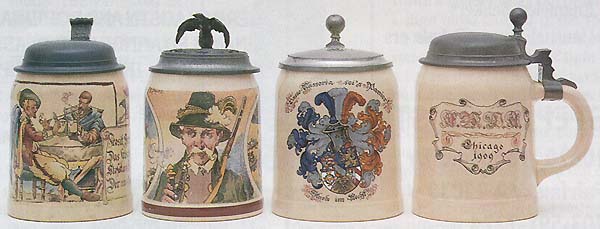
by Robert Wilson and Gary Kirsner
We can identify about a dozen major types of manufacturing techniques used by Villeroy and Boch to produce beer steins and other wares at their factory in the town of Mettlach. Most of the categories are rarely confused with each other, but there are three types of production that can be difficult to differentiate: print under glaze; print over glaze; and hand-painted wares. To help eliminate confusion, let’s start with a description of each of these three decorating techniques.
Print Under Glaze is the use of a transfer printed scene which is applied to the object being decorated. A transfer print or decal is simply a picture which has been printed, usually in large quantities, that can be applied to any object having the proper size or proportions. In the case of Mettlach steins and plaques, print under glaze decorations are protected by a glaze applied over the decoration. It should be noted that some of the Print Under Glaze steins were transfer print outlines with hand-painting. The characteristics of the decorations of these steins are consistent with other Print Under Glaze steins as outlined below.
Print Over Glaze is a technique differing from Print Under Glaze only in that the decoration is not protected by a layer of glaze after it has been applied.
Hand-Painted decorations can involve two different techniques. The first is the application of the design by an artist using a paint brush and/or air brush directly on the object being decorated. The second involves the use of a transfer printed decoration which has been enhanced by an artist-applied decoration. These hand-painted transfer decorations are protected by a glaze and are therefore usually referred to as Print Under Glaze.
 |
While modern printing techniques usually create a dot pattern that is easy to detect with magnification, the printed transfer decorations that were applied to Mettlach wares are much more difficult to differentiate from hand-painted brush strokes. Frequently, applying one or more of the following seven rules will make it easier to determine what type of decoration has been used:
1. The presence of a decoration number (not to be confused with the form number) is an indication of a print under glaze decoration or a hand-painted transfer under glaze decoration. Decoration numbers are printed or hand-painted whereas form numbers are incised. The decoration number will usually establish the type of decoration.
2. American brewery decorations are usually print over glaze. They do not have decoration numbers, and most of these are mugs or steins without lids. There are American brewery steins that were print under glaze but do not have decoration numbers, and these are usually steins with original factory lids.
3. Steins without a decoration number that do not depict events, organizations or places are frequently hand-painted. These are found on such body form numbers as 62 and 280.
4. Steins that have original factory lids with scenes of places, events or organizations are usually print under glaze. These are found with body form numbers including 1526, 1909 and 2140.
5. Detectable wear to the colors of the decoration is an indication of hand-painting or print over glaze.
6. A smooth surface with almost no detectable variation or texture is an indication of print under glaze.
7. In steins having a surface that is not quite smooth, a textured feel to the decoration is an indication of print over glaze or hand-painting.
__________
*Reprinted from The Beer Stein Journal, August 1994, by permission from Gary Kirsner Auctions.